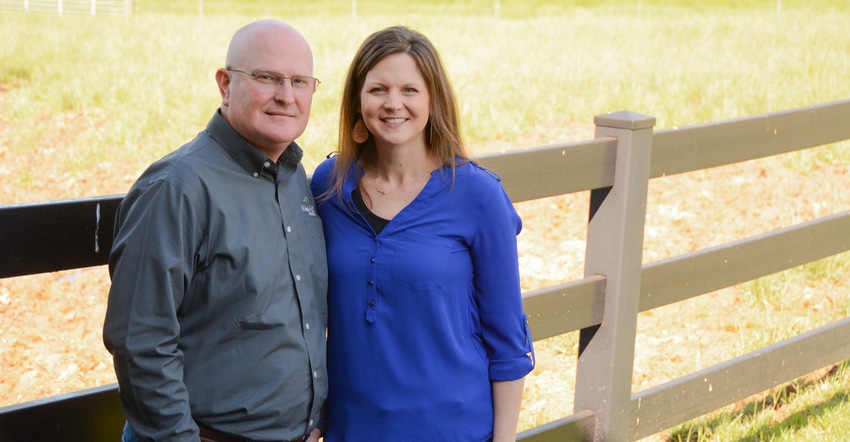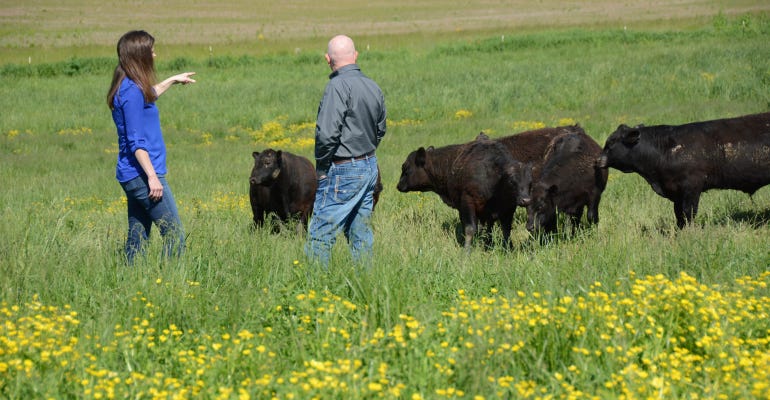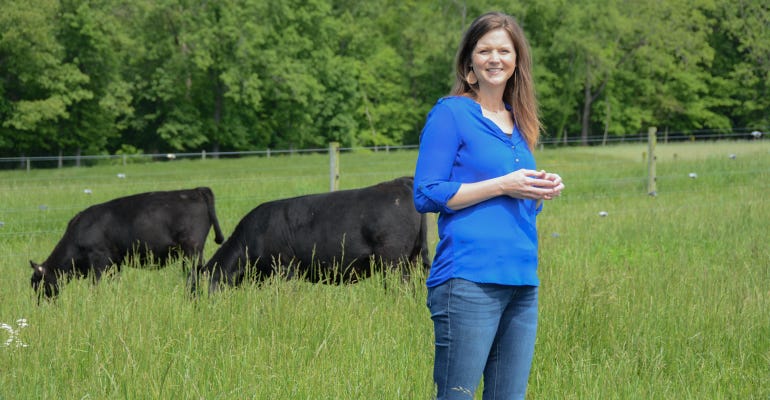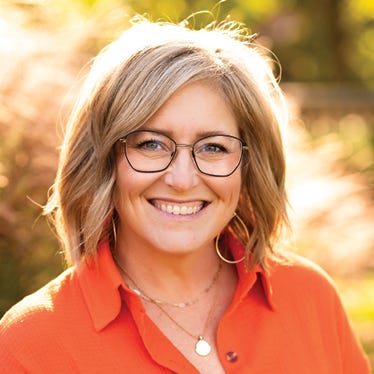
What do you get when you pair an international swine geneticist with the former Hancock County Beef Queen?
Answer: a whole new way to look at breeding cattle. And big opportunities when you’re building a cattle herd from scratch.
So it is for Bradley and Kimberly Wolter, a southern Illinois farm family who are redefining beef cattle production ��— and profitability — on their Aviston farm, Windy Hill Meadows, and bringing a network of farm families along for the ride.
“The base of all this is that we want to develop our kids with a strong work ethic, we want to develop great genetics, and we want to benefit other family farms,” Kimberly says.
Then she laughs and says, “It’s a giant science project.” Bradley can’t argue that point.
“This is her 4-H project, and I’ve trainwrecked it into something that’s become a pain in her neck!” he says, laughing.
So while Bradley is the animal scientist mastermind, Kimberly’s the cattlewoman, having grown up with cattle on her family’s western Illinois farm. Fence breaks? She fixes it. Bulls get out? She (and their kids, Lauren and Blake) get them back in. Data needs inputted to the American Angus Association? She does it, along with using QuickBooks to expertly track financial data with their network of partners and cattle in 13 locations.
The pair met at the University of Illinois, where Kimberly pursued a degree in ag economics and spent her early career in food-service sales for DOT Foods. Bradley earned a doctorate in swine genetics and is CEO of The Maschhoffs, where he’s spent the past two decades transforming the company’s genetic approach to raising profitable pork.
Profitability
It didn’t take Bradley long to apply what he was learning about pig production to their cattle operation. It’s a fescue-based Midwestern cattle business that currently numbers 165 cows, with the goal of building to 300 cows.
“When I came to The Maschhoffs, my passion was about business improvement and recognizing that in meat production, the No. 1 lever is the animal. The animal creates your profit potential,” he says. “If you’re not working with top-tier animals, you’ve already minimized your profitability.”
In other words: Use good genetics; then get out of the way and let the animal be profitable.
“If you’re in meat animal production, you have to have the best profit-potential animal in the business,” Bradley says. That’s what he did at The Maschhoffs, where four genetic lines are at the heart of the business.

NO BULL: This group of bulls is on development on pasture near the Wolters’ farm. They’ll be sold privately, with many already spoken for.

Fifteen years ago, when Bradley and Kimberly started their operation and decided on a breed, they chose Angus in part because of the data they offered. (The Angus junior program was another reason.) So, Bradley spent a couple of months that winter — “just for giggles” — dumping the entire Angus database to his computer and sorting the data. He put together a profit function that emphasized reproduction, feed conversion and carcass quality, and started to sort. What he learned was striking.
At that time, he discovered the two most heavily used Angus bulls were producing the best and worst outcomes in his profit analysis — or the best and worst cattle in the breed. “That means somebody’s got to be wrong here,” he observes.
He also learned that two southern Illinois farmers could each use a different bull and end up with a $260-per-head difference — all due to genetic variation. In hogs, they look at a $2- to $3-per-head difference.
“That’s how I knew there was opportunity,” Bradley says. “The top 10 boars would have been within pennies of each other. It’s hugely different in the cattle business.”
He’s also observed that beef cattle genetics are often about marketing — and the best marketing campaign with the glossiest sale catalogs can still sell genetics that don’t pay.
Profit is important. Whether you have 25 cows that produce $0 profit or $260 profit, the work is the same. “That’s the moral of the story,” Bradley adds.
Profit function
When Bradley did his initial statistical run on the Angus association data, he identified the top five cow families in the country. The Wolters bought a show heifer for their daughter from one of those cow families, the Proven Queen family, and they bought animals initially on the basis of sires that ranked high on their profit function.
Profit function is a term used heavily in genetic improvement, but it boils down to a breeding objective on the basis of economics. What do you want to improve, and how will it improve your bottom line?
The Wolters’ profit function values reproduction, feed conversion and carcass quality, with emphasis on the first two. They measure heifer pregnancy rate, which is the animal’s ability to breed early and stay bred, which determines her ability to stay in the herd long term. They also identified other traits they can measure, like foot quality, where they evaluate claw set and foot angle over time. They also use ultrasound on bulls and heifers, measuring rib-eye area, marbling, growth rate and more.
“The art of animal breeding is to develop breeding objectives — pick the traits you can measure, record accurately and develop a marginal economic value for,” Bradley says.

TRACKED: Kimberly can check on WHM Proven Queen 1884 straight from the pasture, using the American Angus Association’s mobile app.

Scale and size
As the resident cattlewoman, Kimberly’s quick to say they select for good milk, carcass quality, sound feet and legs, and docility.
“Where we are, with cows in both western Illinois and southern Illinois, it’s rolling, rough pasture ground. They’ve got to be functional and ready to move,” she says. “There is no perfect cow, so we have to keep selecting for good mamas that can get the job done and raise a calf every year.”
Bradley uses the Angus association data, but he also knows the only dataset he can control and that can be truly valuable to them is their own. “Everybody throws data into a breed association,” he says. “But people record with different levels of integrity, and some don’t do it at all. At the end of the day, data can become pretty sketchy.”
That’s why their goal is 300 cows. “What we do is different because we have an effective population size, pulling 100% complete and accurate information across all these different farms, and all under my protocol,” Bradley describes. “In theory, it’s not different from what an association is doing, but not all members provide the same rigor.” Plus, he’s selecting based on his Midwest fescue-based profit function; his whole population is set up to maximize profit in that environment.
They pull bulls and heifers into separate development programs, where they track, ultrasound and measure maternal and carcass traits. Heifers that make the cut go back in the herd. Bulls are sold privately, many to repeat buyers. From those bull customers, the Wolters will buy back their calves, if they’re raised under their health and nutrition protocols. Those calves go to a neighboring feedlot, where more data is collected. The feedlot calves either go to Tyson in Joslin, Ill., or to Creekstone Farms, a Kansas processor that’s part of Walmart’s new Angus beef supply chain.
Kimberly also sells halves and quarters to local customers, and they sell through a local meat processor in Louisville.
Start to finish
Theirs is an end game, for sure, but the process is just as important. They’re collecting data on every animal, and they’re training their kids along the way. Add “kid development” to their heifer and bull development protocols.
“We want phenotypically-pleasing cows that are also proven,” Kimberly says. “And it’s all hands on deck around here, so I want docile animals that I can trust with the kids.”
Theirs is a unique combination of talents and skills, with a specific end goal in mind.
“We’re passionate about helping the livestock business improve profitability on the basis of the potential of the animal,” Bradley says.
Kimberly agrees. “We’re dreamers. We seized an opportunity to try to develop something special.”

CATTLEWOMAN: “I’ve always had a passionate for and an interest in beef cattle,” says Kimberly Wolter, who grew up raising and showing cattle on her parents’ farm near Augusta, Ill. When she and Bradley realized they couldn’t raise pigs due to biosecurity concerns associated with his job, cattle were the obvious next choice.

Building the community
The Wolters are passionate about cattle, but as they describe it, they’re even more passionate about people. They’ve turned what was originally a limitation — land — into an opportunity to work with a network of family farmers.
As Kimberly explains, Aviston is an active bedroom community to the greater St. Louis area, which means land is in high demand and pasture is scarce. A barn and 20 acres doesn’t make for a cattle empire out the back door. Here’s how they’ve partnered with families to grow their herd and their genetic base.
Western Illinois cow-calf herd. Bradley and Kimberly bought out her dad’s herd near Augusta. Today, nearly 100 cows are managed by Tom Rankin and family, a deal that started when the Rankins bought bulls from them.
Southern Illinois cow-calf herd. The Wolters were able to purchase pasture about an hour south of their home operation, near Steeleville. That cow herd numbers 55 and is managed by Dalton Eilers.
Heifer development. They rent barn and facility space from Dan Feldman near Aviston.
Bull development. Bulls run on rented pasture next door. The Wolter kids are responsible for evening feedings there.
Bred heifers. Neighbor Mike Poettker selects elite heifers from their commercial herds for development, breeding and sale as replacement stock to other producers.
Feedlot. They rent a barn and are in partnership with Sugar Creek Valley Farms, a family operation that used to develop dairy steers.
Feedlot cattle. The Wolters have a program to buy back calves from any bull buyer who follows their development protocol. Those calves go into the feedlot.
Packers. They send 180 head annually either to IBP at Joslin, Ill., or to Creekstone Farms in Kansas, a packer that is part of Walmart’s new beef supply chain.
Beef sales. Kimberly sells halves and quarters locally on about 50 head of steers, which are processed at one of several locally owned processing plants in Clinton County.
Counter sales. Quinn and Samantha Bible run Salt and Strings Butchery, a meat processing and catering business at Louisville. They want a high-quality, dependable beef supply, so they buy 20 head a year from the Wolters.
It’s a long list but one that’s manageable, thanks to Kimberly’s accounting system and desire to work with everyone in the industry — from calving to butchering.
“It’s really the people,” Bradley concludes. “That’s the attraction. We want to work with each family and provide the genetics to make everyone successful.”
About the Author(s)
You May Also Like






